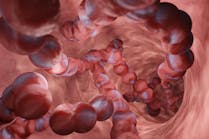Random vs. timed urine potassium
Q What is the use of the random urine K
test? It seems that most physicians do not order this test to
investigate the causes of hypokalemia. Does the urine concentration
affect the result and interpretation?
A Hyopkalemia and hyperkalemia are common clinical
problems, the causes of which can usually be determined from the clinical
history. In some cases, however, the diagnosis is not readily apparent and
measurement of urine-potassium concentrations can be helpful in determining
the etiology of hypokalemia or hyperkalemia. Determination of potassium
concentrations in a random collection of urine is the simplest test to
perform. For example, in a patient with hypokalemia, a random
urine-potassium of 20 mmol/L or less is the appropriate response by the
kidney. A random urine-potassium of greater than 40 mmol/L would be
indicative of renal-potassium wasting, and values between 20 mmol/L and 40
mmol/L would be considered non-diagnostic.
Determination of potassium in a random collection of
urine is subject to some drawbacks. One potential problem is that a random
collection can be adversely affected by a change in urine-water
concentrations. For example, an increase in the concentration of
antidiuretic hormone will increase the concentration of all urine solutes,
including potassium, while not affecting the total excretion of potassium.
Another problem is that random urine-potassium determinations provide
information for only a single point in time. Thus, the most accurate
assessment of urine-potassium excretion is obtained with measurement of
potassium from urine collected over a period of time, typically 24 hours.1
Unfortunately, collection of urine over timed periods is not feasible in
many cases. Obtaining a 24-hour potassium-excretion rate is not practical in
a medical emergency, and patient compliance with collection of all urine
voided over a 24-hour time period is often suboptimal.
Alternate methods to assess urine-potassium excretion
have been proposed as a way of dealing with the limitations of random
urine-potassium measurements. The fractional excretion of potassium (FEK)
has been proposed as a useful marker of potassium excretion.2 The
FEK relates the amount of potassium excreted to the amount that has been
filtered. Calculation of the FEK requires that potassium and creatinine be
measured in both urine and serum. The FEK is calculated as: FEK = (uK x sCr
x 100) / (sK x uCr).
proposed as a way of dealing with the limitations of random
urine-potassium measurements.
The FEK can help identify the etiology of
hyperkalemia and hypokalemia. In individuals with hyperkalemia, an FEK <10%
suggest that the hyperkalemia is due to renal causes. In patients with
hypokalemia, an FEK <10% suggests that hypokalemia is of extrarenal origin.
Fractional excretion values >10% in an individual with hyperkalemia suggests
that hyperkalemia is due to extrarenal causes, or if hypokalemia is the
underlying problem, hypokalemia is of renal origin.
Another index that has been proposed for the
evaluation of urine-potassium loss is the transtubular potassium gradient
(TTKG). This simple index allows the potassium-secretory process to be
evaluated independently of the urine flow rate.3,4 The TTKG is
calculated as: TTKG = uK/[(Posm/Uosm)/sK)].
Use of the TTKG requires that the urine osmolality be
greater than the plasma osmolality. Also, urine-sodium concentrations should
be greater than 25 mmol/L so that sodium delivery is not a limiting factor.
Individuals with hyperkalemia or with high potassium intake and normal renal
function should excrete potassium into the urine resulting in a TTKG above
10. Values <7 in an individual with hyperkalemia suggest mineralocorticoid
deficiency, especially if accompanied by hyponatremia and high urine sodium.
Individuals with hypokalemia should have TTKG values <2; higher values
suggest that potassium secretion is inappropriately stimulated.5
—Steven C.
Kazmierczak, PhD, D(ABCC)
Department of Pathology
Oregon Health & Sciences University
Portland, OR
References
Weiner JD, Wingo CS. Hypokalemia — consequences,
causes, and correction. J Am Soc Nephrol. 1997;8:1179-1188.
Battle DC, Arruda JAL, Kurtzman NA. Hyperkalemic
distal renal tubular acidosis associated with obstructive uropathy. N
Engl J Med. 1982;74:148-151.
West ML, Bendz O, Chen CB, et al. Development of
a test to evaluate the transtubular potassium concentration gradient in
the cortical collecting duct in vivo. Miner Electrolyte Metab.
1986;12:226-233.
West ML, Marsden PA, Richardson RM, et al. New
clinical approach to evaluate disorders of potassium excretion. Miner
Electrolyte Metab. 1986;12:234-238.
Ehier JH, Kamel KS, Magner PO, et al. The
transtubular potassium gradient in patients with hypokalemia and
hyperkalemia. Am J Kidney Dis. 1990;15:309-315.
Vortexing hematology samples
Q I am a faculty member in an MLT school. My students
recently came back from their practicums in hematology and said that when
the Sysmex notes a platelet-clumping error, they were told to vortex the
EDTA tube and retest it. Is this a valid procedure?
A Platelet clumping is a common problem in the
hematology laboratory, frequently leading to reports of spurious
thrombocytopenia and sometimes spurious leukocytosis. Platelet clumping
could be due to platelet aggregation or agglutination.
Platelet aggregation is caused by poor venipuncture,
capillary-blood draw, overfilling of the sample tube, or insufficient mixing
of the sample tube, which initiates coagulation resulting in fibrin-strand
formation with entrapped platelets. Platelet agglutination usually is
secondary to EDTA. This EDTA-induced platelet clumping has been reported in
healthy individuals and in association with individuals with a variety of
diseases,1 such as infections like HIV, rubella, and
cytomegalovirus; autoimmune disorders; neoplastic diseases; and thrombotic
disorders. It occurs with an incidence of approximately 0.1% in the general
population. The pathophysiological nature of EDTA-induced platelet clumping
remains unclear. Many indirect observations support the hypothesis that this
clumping is caused by an alteration of the platelet-surface glycoproteins
when they are incubated with a calcium chelator such as EDTA. These modified
platelet antigens then react to anti-platelet autoantibodies (IgA, IgG, and
IgM) to form these agglutinates.
capillary-blood draw, overfilling of the sample tube, or insufficient
mixing of the sample tube.
Using a vortex to disaggregate platelet clumps has
been investigated by two groups, one of which used human blood samples while
the other one involved veterinary feline specimens. In the study by Gulati,
et al, 188 human whole-blood specimens with platelet clumps were vortexed
for one to two minutes at the highest setting on the vortex. Shortly
following vortexing, the samples were rerun; and new peripheral smears were
made. Vortexing did not significantly alter other CBC parameters. In 43.6%
of cases platelet clumps were no longer seen on smears, with an average 73%
increase in platelet count. In 49.5% of cases, there was partial resolution
of clumping, with a 111% percent increase in platelet counts. No change was
identified in 6.9% of samples.2 In the study on feline
whole-blood samples by Tvedten and Korcal, vortexing increased platelet
counts in 39 of 42 samples with complete resolution of clumps in five of 42
samples. Significant alterations in white-blood-cell (WBC) counts were not
observed.3
While there is a theoretical risk of hemolysis with
vortexing, neither study commented on the presence of increased numbers of
schistocytes in post-vortex smear samples. Comparison of pre-vortex and
post-vortex automatic complete blood count (CBC) and histogram in addition
to examination pre-vortex and post-vortex smears will help to determine if
there is platelet clump disaggregation and if there is vortex-induced
red-blood-cell (RBC) fragmentation. If the laboratory uses flow-cytometry-based
platelet count with platelet antibodies (CD41 or CD61), the presence of RBC
fragments would not affect platelet counts.
At our institution, if fewer than 20% platelets are
clumped by microscopic examination, numeric platelet count by the hematology
analyzer is reported with a comment that few platelet clumps are present. If
marked platelet clumping is seen (>20% platelets), a numerical platelet
count is not given and a re-draw is recommended. If subsequent samples show
platelet clumping and the phlebotomy technique is correct, then an
alternative anticoagulant such as citrate is recommended.
A vortex might be used to decrease platelet clumps in
some cases; each laboratory should test a set of samples to establish proper
vortex condition (speed and time) to dissociate platelet clumps but not
cause RBC fragmentation. If there are increased microscopic fibrin clots, a
redraw should be requested.
—David Gray, MD
—Guang Fan, MD, PhD
Department of Pathology
Oregon Health and Science University
Portland, OR
References
- Berkman N, Michaeli Y, Or R, et al. EDTA-dependent
pseudothrombocytopenia: a clinical study of 18 patients and a review of
the literature. Am J Hemato. 1991:36(3):195-201. - Gulati GL, Asselta A, Chen C. Using a vortex to disaggregate
platelet clumps. Lab Med. 1997:28;665-667. - Tvedten H, Korcal D. Vortex Mixing of Feline Blood to Disaggregate
Platelet Clumps. Vet Clin Pathol. 2001:30;104-106.
Value of stool studies
Q We have several physicians affiliated with our
hospital who order RBC on stool studies. Some of the techs have been
performing and reporting occult blood for this order. Recently, our section
leader said that the physician did not want an occult blood when this test
is ordered. This section leader has stated that we will do a Wright's stain
and look for intact RBCs. We are to report RBCs as present or not present
when we have an order for RBC on a stool specimen. Considering how diverse
fecal matter can appear on a Wright's stain, I am not comfortable with
reporting RBCs from a Wright's stain. Can you please comment?
A Bleeding in the GI tract can occur in a number of
conditions. In some cases, such as colon polyps and cancer, bleeding is a
valuable clue in detecting the disease. In this case, chemical studies for
occult blood are the preferred technique. Detecting intact red blood cells
in formed stool is technically difficult and insensitive.
Upper GI diseases such as chronic esophagitis, and
stomach and duodenal ulcers can cause bleeding; but unless the bleeding is
massive, the red cells will not remain intact in their passage down the
bowel. The presence of bleeding is not an important diagnostic clue in these
diseases.
Bleeding also occurs in inflammatory bowel diseases
such as ulcerative colitis. Diagnosis and monitoring of clinical-disease
activity are based on symptoms such as gross blood in the stool, frequency
and urgency of bowel movements, fever, and abdominal pain along with studies
such as X-rays and colonoscopy.
In infectious and parasitic bowel diseases, finding
bleeding is not an important clinical marker. Sometimes clinicians will ask
for studies for white blood cells, but chemical studies, like the
lactoferrin latex agglutination test, are preferred to the microscopic exam
for white blood cells because it is more sensitive. The clinical value of
fecal leukocyte testing, either by microcopy or chemically, is unclear.1
—Daniel M. Baer, MD
(Deceased)
Reference
- Lung E. Acute Diarrheal Diseases. In: Friedman SL, McQuaid KR,
Grendell JH, editors. Current Diagnosis and Treatment in
Gastroenterology, 2nd ed., New York, NY: Lange Medical
Books/McGraw-Hill, Medical Publishing Division; 2003:131-150.
Brad S. Karon, MD, PhD, is assistant professor of
laboratory medicine and pathology, and director of the Hospital Clinical
Laboratories, point-of-care testing, and phlebotomy services at Mayo
Clinic in Rochester, MN.






